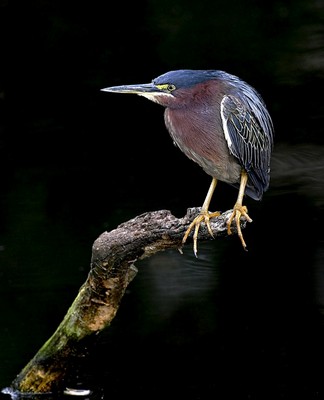
19 Apr First Green heron pair nesting in Land of Crocodiles

Photo by Charles Wesley
Written by Lauren Belcher
A Green heron (Butorides virescens) pair has been spotted at St. Augustine Alligator Farm Zoological Park!
This pair built their nest above the Cuban crocodile exhibit in The Land of Crocodiles. Although this is normal behavior for the species, this is an uncommon spot compared to the rest of the nesting wading bird population in The Rookery.
Green herons are extremely secretive and solitary birds. They are intolerant of other birds when feeding, which is one reason why they are often seen alone. When nesting, pairs are seasonally monogamous and typically nest in mostly unpopulated wooded areas above water.
Still early in their breeding season, this is the only pair observed so far this year. Last year was by far the busiest season in The Rookery for Green heron parents. We had a total of 7 confirmed nests. Hopefully this season will surpass last year’s numbers!
Green herons are about the size of a large crow. They are mostly greenish-black with a chestnut-colored neck and bright yellow legs that turn red-orange when in breeding plumage. The bill is dark with a long, sharp point.
These birds have very distinct calls. While in flight, Green herons will make sharp kyow or skeow sounds. They will also make a loud noise before taking flight if startled. Sometimes, Green herons will let you know they are around by loudly squawking. During courtship, males can be heard making rahh and roo calls and making loud wingbeats.
Some people call Green herons one of the most intelligent bird species around. This is mostly due to their unique style of feeding. Green herons are one of the few species that use tools to help them hunt.
These birds will find food – breadcrumbs, insects, etc. – and place it along the water’s edge and wait for a fish to come up and inspect it. Once the fish takes the bait, the Green heron quickly grabs the fish and eats it in one snap-like fluid motion. Like most wading birds, Green herons are incredible at standing still and stalking their prey.
Green herons are opportunistic feeders. They will eat small fish, aquatic insects, small mammals and amphibians. They are typically nocturnal birds, often retreating into the trees during the daylight hours.
Green herons breeding period is influenced by rainfall and prey availability. Populations begin to move in March and April and breeding is well on its way by May.
Green herons typically lay 2-6 eggs that are pale green in color. The nest is made out of thin, long sticks and is constructed by both parents. Eggs are laid in 2-day intervals and take about 20 days to incubate and hatch.
This means in a few weeks we are going to start seeing little Green heron hatchlings! Come by The St. Augustine Alligator Farm Zoological Park to see if you can find any more Green herons nesting.
